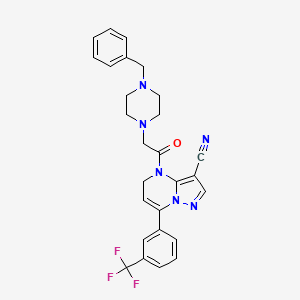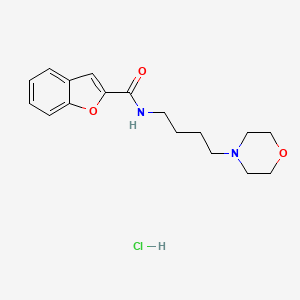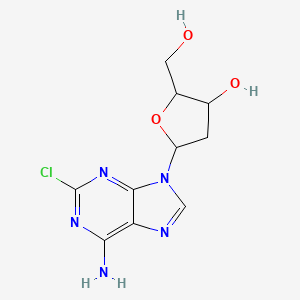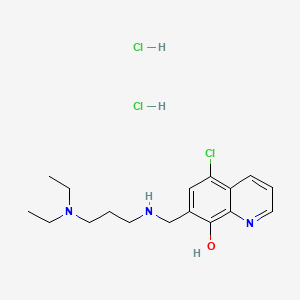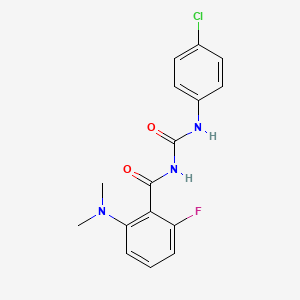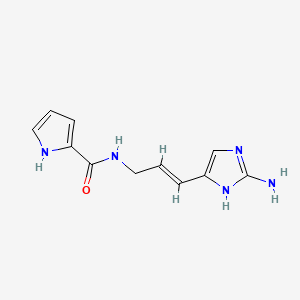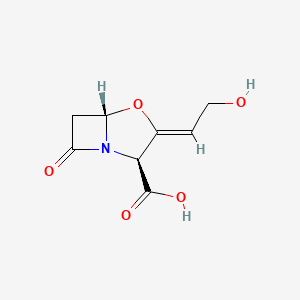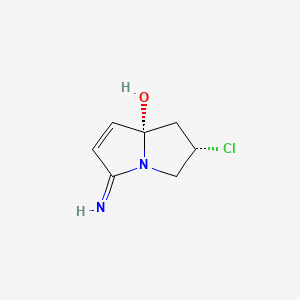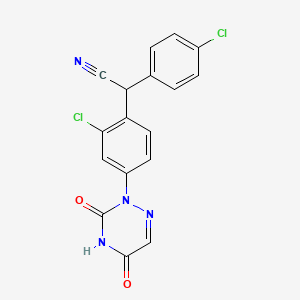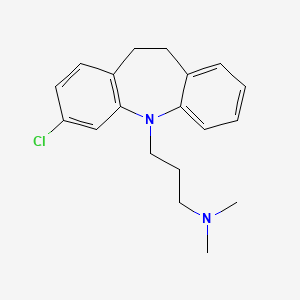
Clomipramina
Descripción general
Descripción
La clomipramina es un antidepresivo tricíclico utilizado principalmente para tratar el trastorno obsesivo-compulsivo. También es eficaz en el tratamiento de otras afecciones, como el trastorno depresivo mayor, el trastorno de pánico y el dolor crónico. La this compound fue descubierta en 1964 por el fabricante farmacéutico suizo Ciba-Geigy y se vende bajo la marca Anafranil, entre otras .
Mecanismo De Acción
La clomipramina actúa inhibiendo la recaptación de serotonina y norepinefrina en el sistema nervioso central. Esto da como resultado concentraciones aumentadas de estos neurotransmisores en la hendidura sináptica, lo que lleva a una mayor neurotransmisión. El compuesto también bloquea los receptores de histamina-H1, los receptores adrenérgicos α1 y los receptores muscarínicos, contribuyendo a sus efectos sedantes, hipotensores y anticolinérgicos .
Compuestos similares:
Imipramina: Otro antidepresivo tricíclico utilizado para indicaciones similares.
Amitriptilina: Conocido por sus propiedades sedantes y utilizado en el tratamiento de la depresión y el dolor crónico.
Nortriptilina: Un antidepresivo tricíclico de amina secundaria con un perfil de efectos secundarios diferente.
Singularidad de la this compound: La this compound es única debido a su fuerte inhibición de la recaptación de serotonina en comparación con otros antidepresivos tricíclicos. Esto la hace particularmente efectiva en el tratamiento del trastorno obsesivo-compulsivo. Además, su metabolito, desmetilthis compound, inhibe preferentemente la recaptación de norepinefrina, proporcionando un doble mecanismo de acción .
Aplicaciones Científicas De Investigación
La clomipramina tiene una amplia gama de aplicaciones de investigación científica:
Química: Se utiliza como compuesto modelo en el estudio de los antidepresivos tricíclicos.
Biología: Investigado por sus efectos sobre los sistemas de neurotransmisores y la autofagia neuronal.
Industria: Utilizado en el desarrollo de herramientas de diagnóstico y sensores ecológicos.
Métodos De Preparación
Rutas sintéticas y condiciones de reacción: La clomipramina se sintetiza a través de un proceso de varios pasos que comienza con la iminodibencilo. Los pasos clave incluyen:
Cloración: La iminodibencilo se clora para formar 3-cloroiminodibencilo.
Reducción: El producto clorado se reduce a 3-cloro-10,11-dihidro-5H-dibenzo[b,f]azepina.
Alquilación: El paso final consiste en la alquilación con cloruro de 3-dimetilaminopropilo para producir this compound.
Métodos de producción industrial: La producción industrial de this compound suele seguir la misma ruta sintética, pero a mayor escala. El proceso implica un control estricto de las condiciones de reacción para garantizar una alta pureza y rendimiento. El producto final se convierte a menudo en su forma de sal de clorhidrato para obtener estabilidad y facilitar la formulación .
Análisis De Reacciones Químicas
Tipos de reacciones: La clomipramina se somete a varios tipos de reacciones químicas, que incluyen:
Oxidación: La this compound puede oxidarse para formar su derivado N-óxido.
Reducción: El compuesto puede reducirse a su metabolito desmetilado, desmetilthis compound.
Sustitución: Las reacciones de halogenación y alquilación pueden modificar la molécula de this compound.
Reactivos y condiciones comunes:
Oxidación: Se utilizan comúnmente peróxido de hidrógeno o perácidos.
Reducción: El hidruro de aluminio y litio o el borohidruro de sodio son agentes reductores típicos.
Sustitución: Agentes halogenantes como cloro o bromo, y agentes alquilantes como haluros de alquilo.
Principales productos formados:
Desmetilthis compound: Formadas a través de la reducción.
Derivado N-óxido: Formado a través de la oxidación.
Comparación Con Compuestos Similares
Imipramine: Another tricyclic antidepressant used for similar indications.
Amitriptyline: Known for its sedative properties and used in the treatment of depression and chronic pain.
Nortriptyline: A secondary amine tricyclic antidepressant with a different side effect profile.
Uniqueness of Clomipramine: Clomipramine is unique due to its strong inhibition of serotonin reuptake compared to other tricyclic antidepressants. This makes it particularly effective in treating obsessive-compulsive disorder. Additionally, its metabolite, desmethylclomipramine, preferentially inhibits norepinephrine reuptake, providing a dual mechanism of action .
Propiedades
IUPAC Name |
3-(2-chloro-5,6-dihydrobenzo[b][1]benzazepin-11-yl)-N,N-dimethylpropan-1-amine | |
|---|---|---|
| Source | PubChem | |
| URL | https://pubchem.ncbi.nlm.nih.gov | |
| Description | Data deposited in or computed by PubChem | |
InChI |
InChI=1S/C19H23ClN2/c1-21(2)12-5-13-22-18-7-4-3-6-15(18)8-9-16-10-11-17(20)14-19(16)22/h3-4,6-7,10-11,14H,5,8-9,12-13H2,1-2H3 | |
| Source | PubChem | |
| URL | https://pubchem.ncbi.nlm.nih.gov | |
| Description | Data deposited in or computed by PubChem | |
InChI Key |
GDLIGKIOYRNHDA-UHFFFAOYSA-N | |
| Source | PubChem | |
| URL | https://pubchem.ncbi.nlm.nih.gov | |
| Description | Data deposited in or computed by PubChem | |
Canonical SMILES |
CN(C)CCCN1C2=CC=CC=C2CCC3=C1C=C(C=C3)Cl | |
| Source | PubChem | |
| URL | https://pubchem.ncbi.nlm.nih.gov | |
| Description | Data deposited in or computed by PubChem | |
Molecular Formula |
C19H23ClN2 | |
| Source | PubChem | |
| URL | https://pubchem.ncbi.nlm.nih.gov | |
| Description | Data deposited in or computed by PubChem | |
Related CAS |
17321-77-6 (mono-hydrochloride) | |
| Record name | Clomipramine [INN:BAN] | |
| Source | ChemIDplus | |
| URL | https://pubchem.ncbi.nlm.nih.gov/substance/?source=chemidplus&sourceid=0000303491 | |
| Description | ChemIDplus is a free, web search system that provides access to the structure and nomenclature authority files used for the identification of chemical substances cited in National Library of Medicine (NLM) databases, including the TOXNET system. | |
DSSTOX Substance ID |
DTXSID6022844 | |
| Record name | Clomipramine | |
| Source | EPA DSSTox | |
| URL | https://comptox.epa.gov/dashboard/DTXSID6022844 | |
| Description | DSSTox provides a high quality public chemistry resource for supporting improved predictive toxicology. | |
Molecular Weight |
314.9 g/mol | |
| Source | PubChem | |
| URL | https://pubchem.ncbi.nlm.nih.gov | |
| Description | Data deposited in or computed by PubChem | |
Physical Description |
Solid | |
| Record name | Clomipramine | |
| Source | Human Metabolome Database (HMDB) | |
| URL | http://www.hmdb.ca/metabolites/HMDB0015372 | |
| Description | The Human Metabolome Database (HMDB) is a freely available electronic database containing detailed information about small molecule metabolites found in the human body. | |
| Explanation | HMDB is offered to the public as a freely available resource. Use and re-distribution of the data, in whole or in part, for commercial purposes requires explicit permission of the authors and explicit acknowledgment of the source material (HMDB) and the original publication (see the HMDB citing page). We ask that users who download significant portions of the database cite the HMDB paper in any resulting publications. | |
Boiling Point |
160-170 °C at 3.00E-01 mm Hg, 160-170 °C at 0.3 mm Hg | |
| Record name | Clomipramine | |
| Source | DrugBank | |
| URL | https://www.drugbank.ca/drugs/DB01242 | |
| Description | The DrugBank database is a unique bioinformatics and cheminformatics resource that combines detailed drug (i.e. chemical, pharmacological and pharmaceutical) data with comprehensive drug target (i.e. sequence, structure, and pathway) information. | |
| Explanation | Creative Common's Attribution-NonCommercial 4.0 International License (http://creativecommons.org/licenses/by-nc/4.0/legalcode) | |
| Record name | Clomipramine | |
| Source | Hazardous Substances Data Bank (HSDB) | |
| URL | https://pubchem.ncbi.nlm.nih.gov/source/hsdb/7746 | |
| Description | The Hazardous Substances Data Bank (HSDB) is a toxicology database that focuses on the toxicology of potentially hazardous chemicals. It provides information on human exposure, industrial hygiene, emergency handling procedures, environmental fate, regulatory requirements, nanomaterials, and related areas. The information in HSDB has been assessed by a Scientific Review Panel. | |
Solubility |
1.44e-02 g/L | |
| Record name | Clomipramine | |
| Source | DrugBank | |
| URL | https://www.drugbank.ca/drugs/DB01242 | |
| Description | The DrugBank database is a unique bioinformatics and cheminformatics resource that combines detailed drug (i.e. chemical, pharmacological and pharmaceutical) data with comprehensive drug target (i.e. sequence, structure, and pathway) information. | |
| Explanation | Creative Common's Attribution-NonCommercial 4.0 International License (http://creativecommons.org/licenses/by-nc/4.0/legalcode) | |
| Record name | Clomipramine | |
| Source | Human Metabolome Database (HMDB) | |
| URL | http://www.hmdb.ca/metabolites/HMDB0015372 | |
| Description | The Human Metabolome Database (HMDB) is a freely available electronic database containing detailed information about small molecule metabolites found in the human body. | |
| Explanation | HMDB is offered to the public as a freely available resource. Use and re-distribution of the data, in whole or in part, for commercial purposes requires explicit permission of the authors and explicit acknowledgment of the source material (HMDB) and the original publication (see the HMDB citing page). We ask that users who download significant portions of the database cite the HMDB paper in any resulting publications. | |
Mechanism of Action |
Clomipramine is a strong, but not completely selective serotonin reuptake inhibitor (SRI), as the active main metabolite desmethyclomipramine acts preferably as an inhibitor of noradrenaline reuptake. α1-receptor blockage and β-down-regulation have been noted and most likely play a role in the short term effects of clomipramine. A blockade of sodium-channels and NDMA-receptors might, as with other tricyclics, account for its effect in chronic pain, in particular the neuropathic type., The pharmacology of clomipramine is complex and in many ways resembles that of other antidepressants, particularly those agents (eg, selective serotonin-reuptake inhibitors, trazodone) that predominantly potentiate the pharmacologic effects of serotonin (5-HT). Although clomipramine's principal pharmacologic effect in vitro is the selective inhibition of serotonin reuptake, in vivo the drug's pharmacologic activity is not so selective because of the action of its demethylated metabolite, desmethylclomipramine, as an inhibitor of norepinephrine reuptake. As a result of this and other effects, clomipramine also shares the pharmacologic profile of other tricyclic antidepressants., The precise mechanism of action that is responsible for the efficacy of clomipramine in the treatment of obsessive-compulsive disorder is unclear. However, because of its pronounced potency in blocking serotonin reuptake at the presynaptic neuronal membrane and its efficacy in the treatment of obsessive-compulsive disorder, a serotonin hypothesis has been developed to explain the pathogenesis of the condition. The hypothesis postulates that a dysregulation of serotonin is responsible for obsessive-compulsive disorder and that clomipramine is effective because it corrects this imbalance., Clomipramine and its principal metabolite, desmethylclomipramine, have been shown to block the reuptake of serotonin and norepinephrine, respectively, at the presynaptic neuronal membrane. The effects of serotonin and norepinephrine may thus be potentiated. However, it has been suggested that postsynaptic receptor modification is mainly responsible for the antidepressant action observed during long-term administration of antidepressant agents. During long-term therapy with most antidepressants (eg, tricyclic antidepressants, monoamine oxidase [MAO] inhibitors), these adaptive changes generally consist of subsensitivity of the noradrenergic adenylate cyclase system in association with a decrease in the number of beta-adrenergic receptors; such effects on noradrenergic receptor function commonly are referred to as "down-regulation." In addition, some antidepressants reportedly decrease the number of 5-HT binding sites following chronic administration., Clomipramine's principal metabolite, desmethylclomipramine, is an inhibitor of norepinephrine reuptake. Clomipramine decreases the concentration of 3-methoxy-4-hydroxyphenylglycol (MHPG), a metabolite of norepinephrine, in CSF in patients with obsessive-compulsive disorder. Patients with depressive affective (mood) disorders (e.g., major depressive episode) also exhibit decreases in concentrations of 5-HIAA and MHPG in CSF during treatment with clomipramine. The decrease in the concentration of 5-HIAA in CSF was correlated with inhibition of the in vitro uptake of 3H-serotonin in plasma. The change in concentration of MHPG in CSF during clomipramine therapy was correlated with amelioration of depression., For more Mechanism of Action (Complete) data for Clomipramine (10 total), please visit the HSDB record page. | |
| Record name | Clomipramine | |
| Source | DrugBank | |
| URL | https://www.drugbank.ca/drugs/DB01242 | |
| Description | The DrugBank database is a unique bioinformatics and cheminformatics resource that combines detailed drug (i.e. chemical, pharmacological and pharmaceutical) data with comprehensive drug target (i.e. sequence, structure, and pathway) information. | |
| Explanation | Creative Common's Attribution-NonCommercial 4.0 International License (http://creativecommons.org/licenses/by-nc/4.0/legalcode) | |
| Record name | Clomipramine | |
| Source | Hazardous Substances Data Bank (HSDB) | |
| URL | https://pubchem.ncbi.nlm.nih.gov/source/hsdb/7746 | |
| Description | The Hazardous Substances Data Bank (HSDB) is a toxicology database that focuses on the toxicology of potentially hazardous chemicals. It provides information on human exposure, industrial hygiene, emergency handling procedures, environmental fate, regulatory requirements, nanomaterials, and related areas. The information in HSDB has been assessed by a Scientific Review Panel. | |
Impurities |
N-[3-(3-chloro-10,11-dihydro-5H-dibenzo[b,f]azepin-t-yl)propyl]-N,N',N'-trimethylpropane-1,3-diamine, 3-(3-chloro-5H-dibenzo[b,f]azepin-5-yl]-N,N-dimethylpropan-1-amine, 3-(3,7-dichloro-10,11-dihydro-5H-dibenzol[b,f]azepin-5-yl)-N,N-dimethylpropan-1-amine, 3-chloro-5-[3-(dimethylamino)propyl]-10,11-dihydro-5H-dibenz[b,f]azepine, For more Impurities (Complete) data for Clomipramine (11 total), please visit the HSDB record page. | |
| Record name | Clomipramine | |
| Source | Hazardous Substances Data Bank (HSDB) | |
| URL | https://pubchem.ncbi.nlm.nih.gov/source/hsdb/7746 | |
| Description | The Hazardous Substances Data Bank (HSDB) is a toxicology database that focuses on the toxicology of potentially hazardous chemicals. It provides information on human exposure, industrial hygiene, emergency handling procedures, environmental fate, regulatory requirements, nanomaterials, and related areas. The information in HSDB has been assessed by a Scientific Review Panel. | |
CAS No. |
303-49-1 | |
| Record name | Clomipramine | |
| Source | CAS Common Chemistry | |
| URL | https://commonchemistry.cas.org/detail?cas_rn=303-49-1 | |
| Description | CAS Common Chemistry is an open community resource for accessing chemical information. Nearly 500,000 chemical substances from CAS REGISTRY cover areas of community interest, including common and frequently regulated chemicals, and those relevant to high school and undergraduate chemistry classes. This chemical information, curated by our expert scientists, is provided in alignment with our mission as a division of the American Chemical Society. | |
| Explanation | The data from CAS Common Chemistry is provided under a CC-BY-NC 4.0 license, unless otherwise stated. | |
| Record name | Clomipramine [INN:BAN] | |
| Source | ChemIDplus | |
| URL | https://pubchem.ncbi.nlm.nih.gov/substance/?source=chemidplus&sourceid=0000303491 | |
| Description | ChemIDplus is a free, web search system that provides access to the structure and nomenclature authority files used for the identification of chemical substances cited in National Library of Medicine (NLM) databases, including the TOXNET system. | |
| Record name | Clomipramine | |
| Source | DrugBank | |
| URL | https://www.drugbank.ca/drugs/DB01242 | |
| Description | The DrugBank database is a unique bioinformatics and cheminformatics resource that combines detailed drug (i.e. chemical, pharmacological and pharmaceutical) data with comprehensive drug target (i.e. sequence, structure, and pathway) information. | |
| Explanation | Creative Common's Attribution-NonCommercial 4.0 International License (http://creativecommons.org/licenses/by-nc/4.0/legalcode) | |
| Record name | clomipramine | |
| Source | DTP/NCI | |
| URL | https://dtp.cancer.gov/dtpstandard/servlet/dwindex?searchtype=NSC&outputformat=html&searchlist=169865 | |
| Description | The NCI Development Therapeutics Program (DTP) provides services and resources to the academic and private-sector research communities worldwide to facilitate the discovery and development of new cancer therapeutic agents. | |
| Explanation | Unless otherwise indicated, all text within NCI products is free of copyright and may be reused without our permission. Credit the National Cancer Institute as the source. | |
| Record name | Clomipramine | |
| Source | EPA DSSTox | |
| URL | https://comptox.epa.gov/dashboard/DTXSID6022844 | |
| Description | DSSTox provides a high quality public chemistry resource for supporting improved predictive toxicology. | |
| Record name | Clomipramine | |
| Source | European Chemicals Agency (ECHA) | |
| URL | https://echa.europa.eu/substance-information/-/substanceinfo/100.005.587 | |
| Description | The European Chemicals Agency (ECHA) is an agency of the European Union which is the driving force among regulatory authorities in implementing the EU's groundbreaking chemicals legislation for the benefit of human health and the environment as well as for innovation and competitiveness. | |
| Explanation | Use of the information, documents and data from the ECHA website is subject to the terms and conditions of this Legal Notice, and subject to other binding limitations provided for under applicable law, the information, documents and data made available on the ECHA website may be reproduced, distributed and/or used, totally or in part, for non-commercial purposes provided that ECHA is acknowledged as the source: "Source: European Chemicals Agency, http://echa.europa.eu/". Such acknowledgement must be included in each copy of the material. ECHA permits and encourages organisations and individuals to create links to the ECHA website under the following cumulative conditions: Links can only be made to webpages that provide a link to the Legal Notice page. | |
| Record name | CLOMIPRAMINE | |
| Source | FDA Global Substance Registration System (GSRS) | |
| URL | https://gsrs.ncats.nih.gov/ginas/app/beta/substances/NUV44L116D | |
| Description | The FDA Global Substance Registration System (GSRS) enables the efficient and accurate exchange of information on what substances are in regulated products. Instead of relying on names, which vary across regulatory domains, countries, and regions, the GSRS knowledge base makes it possible for substances to be defined by standardized, scientific descriptions. | |
| Explanation | Unless otherwise noted, the contents of the FDA website (www.fda.gov), both text and graphics, are not copyrighted. They are in the public domain and may be republished, reprinted and otherwise used freely by anyone without the need to obtain permission from FDA. Credit to the U.S. Food and Drug Administration as the source is appreciated but not required. | |
| Record name | Clomipramine | |
| Source | Hazardous Substances Data Bank (HSDB) | |
| URL | https://pubchem.ncbi.nlm.nih.gov/source/hsdb/7746 | |
| Description | The Hazardous Substances Data Bank (HSDB) is a toxicology database that focuses on the toxicology of potentially hazardous chemicals. It provides information on human exposure, industrial hygiene, emergency handling procedures, environmental fate, regulatory requirements, nanomaterials, and related areas. The information in HSDB has been assessed by a Scientific Review Panel. | |
| Record name | Clomipramine | |
| Source | Human Metabolome Database (HMDB) | |
| URL | http://www.hmdb.ca/metabolites/HMDB0015372 | |
| Description | The Human Metabolome Database (HMDB) is a freely available electronic database containing detailed information about small molecule metabolites found in the human body. | |
| Explanation | HMDB is offered to the public as a freely available resource. Use and re-distribution of the data, in whole or in part, for commercial purposes requires explicit permission of the authors and explicit acknowledgment of the source material (HMDB) and the original publication (see the HMDB citing page). We ask that users who download significant portions of the database cite the HMDB paper in any resulting publications. | |
Melting Point |
191.5-192, 189.5 °C | |
| Record name | Clomipramine | |
| Source | DrugBank | |
| URL | https://www.drugbank.ca/drugs/DB01242 | |
| Description | The DrugBank database is a unique bioinformatics and cheminformatics resource that combines detailed drug (i.e. chemical, pharmacological and pharmaceutical) data with comprehensive drug target (i.e. sequence, structure, and pathway) information. | |
| Explanation | Creative Common's Attribution-NonCommercial 4.0 International License (http://creativecommons.org/licenses/by-nc/4.0/legalcode) | |
| Record name | Clomipramine | |
| Source | Human Metabolome Database (HMDB) | |
| URL | http://www.hmdb.ca/metabolites/HMDB0015372 | |
| Description | The Human Metabolome Database (HMDB) is a freely available electronic database containing detailed information about small molecule metabolites found in the human body. | |
| Explanation | HMDB is offered to the public as a freely available resource. Use and re-distribution of the data, in whole or in part, for commercial purposes requires explicit permission of the authors and explicit acknowledgment of the source material (HMDB) and the original publication (see the HMDB citing page). We ask that users who download significant portions of the database cite the HMDB paper in any resulting publications. | |
Retrosynthesis Analysis
AI-Powered Synthesis Planning: Our tool employs the Template_relevance Pistachio, Template_relevance Bkms_metabolic, Template_relevance Pistachio_ringbreaker, Template_relevance Reaxys, Template_relevance Reaxys_biocatalysis model, leveraging a vast database of chemical reactions to predict feasible synthetic routes.
One-Step Synthesis Focus: Specifically designed for one-step synthesis, it provides concise and direct routes for your target compounds, streamlining the synthesis process.
Accurate Predictions: Utilizing the extensive PISTACHIO, BKMS_METABOLIC, PISTACHIO_RINGBREAKER, REAXYS, REAXYS_BIOCATALYSIS database, our tool offers high-accuracy predictions, reflecting the latest in chemical research and data.
Strategy Settings
| Precursor scoring | Relevance Heuristic |
|---|---|
| Min. plausibility | 0.01 |
| Model | Template_relevance |
| Template Set | Pistachio/Bkms_metabolic/Pistachio_ringbreaker/Reaxys/Reaxys_biocatalysis |
| Top-N result to add to graph | 6 |
Feasible Synthetic Routes
Descargo de responsabilidad e información sobre productos de investigación in vitro
Tenga en cuenta que todos los artículos e información de productos presentados en BenchChem están destinados únicamente con fines informativos. Los productos disponibles para la compra en BenchChem están diseñados específicamente para estudios in vitro, que se realizan fuera de organismos vivos. Los estudios in vitro, derivados del término latino "in vidrio", involucran experimentos realizados en entornos de laboratorio controlados utilizando células o tejidos. Es importante tener en cuenta que estos productos no se clasifican como medicamentos y no han recibido la aprobación de la FDA para la prevención, tratamiento o cura de ninguna condición médica, dolencia o enfermedad. Debemos enfatizar que cualquier forma de introducción corporal de estos productos en humanos o animales está estrictamente prohibida por ley. Es esencial adherirse a estas pautas para garantizar el cumplimiento de los estándares legales y éticos en la investigación y experimentación.


![(2-Methoxycarbonyl-3-tetradecoxyphenyl) [3-[(5-methyl-1,3-thiazol-3-ium-3-yl)methyl]phenyl] phosphate](/img/structure/B1669138.png)
![1-(3,4-dichlorophenyl)-3-azabicyclo[3.1.0]hexane Hydrochloride](/img/structure/B1669140.png)

